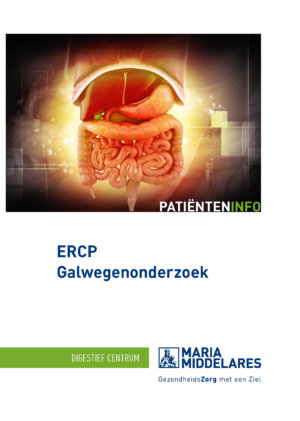ERCP
What is it?
What is it?The combined radiographic and endoscopic test of the gall ducts and the pancreas are performed to detect and treat stones and constrictions.
If your physician recommends an ERCP and you refuse the procedure, this can lead to a late or mistaken diagnosis, with possibly serious consequences or a non-optimal therapy choice.
When?
When?This test will only be performed if your symptoms, along with the clinical examination, lab tests, ultrasound and any echo-endoscopy or scan (CT or MRI) provide good justification for it.
Things to consider
Inform us if:
- you are pregnant: the test is done with X-rays. It is important to let us know if you are (or could be) pregnant
- you have an allergy, sensitivity or intolerance (to latex, Xylocaine, antibiotics, contrast agent, etcetera)
- you have coagulation problems or if you take blood thinners (Marevan, Sintrom, Marcoumar, Ticlid, Plavix, Xarelto, Pradaxa, Aspirin, etcetera)
- you have an artificial valve or prosthesis, then you will be given antibiotics for before and after a procedure
- epilepsy, diabetes, chronic heart, lung and kidney disorders: special attention to medication required.
Leave removable dentures in your room. Damage to teeth (higher risk if teeth are in poor condition) cannot be ruled out during an endoscopy or anaesthesia.
Do not hesitate to ask for further explanation should you have any doubts or queries!
Course of the procedure
Course of the procedurePreparation
- Please arrive at the hospital fasting (for a minimum of six hours).
- Do not smoke on the day of the procedure, and smoke as little as possible in the preceding days.
- Do not take any antacids such as Maalox and Gaviscon on the day before the test.
- Ask for specific guidelines if you have diabetes, epilepsy, chronic heart, lung or kidney disorders or if you take blood thinners.
- Please mention any sensitivity to latex or contrast, if you have any.
- An IV line will be placed in one of your arm veins to administer medication.
Safety and hygiene
We are an experienced and well-trained team, equipped with a modern infrastructure. Before and after each test, each endoscope is thoroughly cleaned and disinfected in an automatic cleaning and disinfection machine in a controlled procedure. Our disinfection protocols meet European standards.
For the treatment of stones and constrictions, exclusively disposable (single-use) materials are almost always used. Any reusable materials are cleaned and sterilised by the Central Sterilisation Department of the hospital.
Process
- The test is performed under anaesthesia because it can last for quite a long time and because the test requires the patient's optimal cooperation.
- During the examination, a flexible tube fitted with a video camera is inserted through the mouth. The papilla or outlet of the bile duct and pancreas is detected.
- In the papillae, a thin instrument, or catheter, is introduced and a contrast agent is injected into the bile duct or pancreas. This allows photos to be taken of the bile duct and pancreas. These photos show the gallstones, constrictions and other pathologies.
- If stones are confirmed, then the papilla opening is widened by using a catheter with an electrical current (e.g. paillotoma). Afterwards, the stones are removed along the papilla using a balloon catheter or captured in a net (e.g. Dormia catheter).
- If a constriction is present in the bile duct or pancreatic duct, this can be bypassed using an artificial tube (e.g. stent or prosthesis).
Because you are asleep during the procedure, you cannot be asked to give your express consent to having a stone removed or a prosthesis placed. If you have given us your consent to perform the procedure, then we will do our best to make the most appropriate decision, keeping in mind the information we have regarding your disease condition.
After the procedure
You will wake up in the recovery room. You will then be transferred to the day hospital. You will usually stay overnight after the procedure.
After the procedure, you may experience throat irritation, mild drowsiness or dizziness (as a result of the anaesthesia).
Possible risks
Possible risksThis is a safe procedure that is usually performed without any problems, but rare complications cannot be ruled out. After the procedure, you also may experience slight discomfort such as throat irritation, stomach discomfort, flatulence, bloated stomach, drowsiness and dizziness. This usually disappears by itself.
With the widening of the papillary opening, there may bleeding or a perforation afterwards in rare cases. This can usually, but not always, be resolved without surgery.
Inflammation of the pancreas (e.g. pancreatitis) seldom occurs after an ERCP. This requires a longer hospital stay, with infusions and pain medication.
Sometimes phlebitis can develop at the IV insertion site (painful swelling). If required, you will be given an ointment for this.
Contact us if you have the following symptoms after the procedure:
- persistent severe pain
- fever
- blood loss (red or black stools)
- any concerning symptom
Downloads
DownloadsOnly available in Dutch:

ERCP: galwegenonderzoek
DownloadCentres and specialist areas
Centres and specialist areas
Latest publication date: 16/05/2024
Supervising author: Dr Monsaert Els



